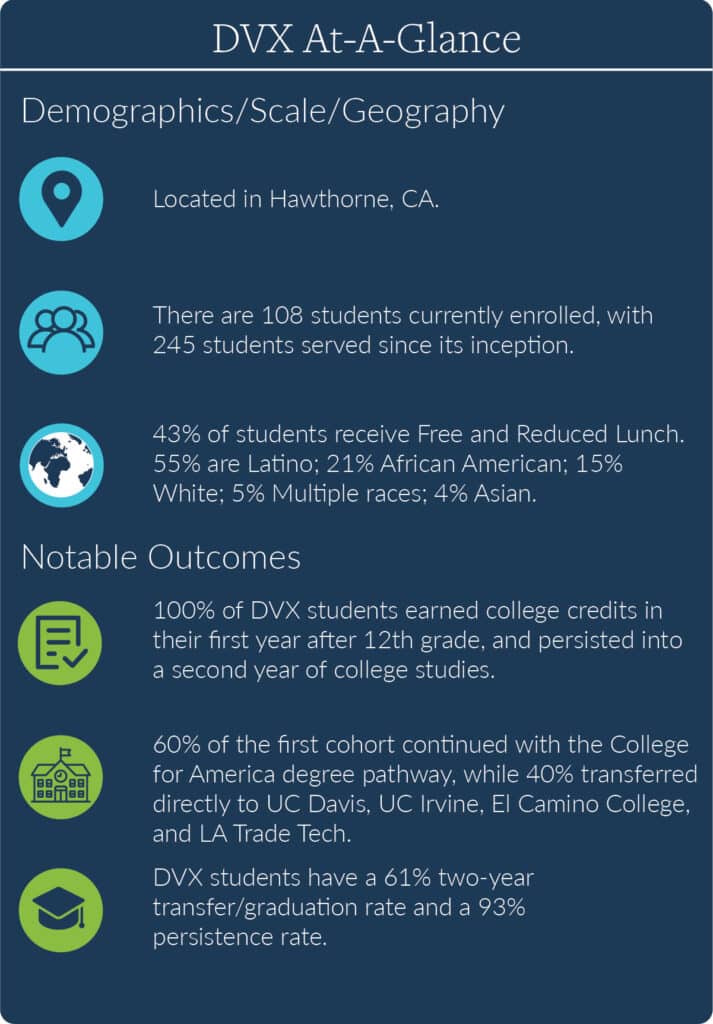Students need relationships to get by and to get ahead. But all too often in our education system, relationships are treated as inputs to learning, rather than outcomes in their own right. In the coming months, we’ll be offering in-depth profiles of programs that are flipping that script and deliberately designing models to deepen and diversify their students’ networks. We’re calling this series Who You Know in Action.
As summer heats up so does internship season. Eager students descend on workplaces to secure the undeniable advantages that internships confer on their resumes. But as work-based learning gains steam in education reform circles, and advocates call for greater access to these experiences for students furthest from opportunity, the internship is no longer reserved for summer months alone. In fact, it’s making its way into the core of some high school and college models.
The more popular these approaches become, schools often struggle to scale internships while maintaining quality. This year we took a closer look at one program’s take on how to scale internships—and in specific, the connections into careers that internships can unlock.

Da Vinci Extension (DVX) is a hybrid college in Hawthorne, Calif. that grew out of Da Vinci Schools, a network of project-based schools in southern California. DVX’s approach has a number of moving parts, but work-based learning is a core feature of its model. At the outset, this commitment to work-based learning meant trying to offer internships to all of its students. But as DVX enrollment grew, it became more difficult to find enough quality internship experiences for students aligned to their career interests. At scale, DVX wasn’t able to generate enough full-semester paid internships with industry partners. And if internship managers were too busy, students would return to DVX saying “I was just sitting around not doing anything.”
That led DVX to reconsider its approach, acknowledging, in the words of then-DVX Director Kim Merritt that “internships aren’t always the right answer. And a poor internship experience may do more harm than good.”
She asked herself: “What are the most impactful aspects of internships? What aspects of the internship experience are just fluff?” Merritt and her team started to play with the dosage and location of work-based learning to identify a minimum viable product of an ‘internship’ experience. As Merritt’s colleague Natasha Morrison, Director of Real-World Learning at Da Vinci Schools, described: “By its nature, the gig economy transforms workforces into consultants; so it felt appropriate to envision our internship model through a similar lens—we examined what value our students could add and how to present industry partners a lower-lift option to authentically engage with and benefit from students.”
A smaller-scale solution: Project consults
Project consults emerged. Smaller groups of DVX students (typically 4-6) formed teams based on their career interests and engaged in real-world projects with industry clients over a 6-8 week period. Students were expected to take over the many moving parts of client- and project- management.
For industry partners, participating in a project consult accomplishes the lighter lift Morrison was hoping for. Prospective clients simply have to fill out a Google form detailing potential projects that students could support. Once Morrison reviews these to assess viability and quality, students can select among a range of options that fit their interests. Unlike 12-week, onsite internships, during the 6-8 weeks of a project consult, student teams primarily meet at DVX’s building rather than at the work site, lessening the burden on employers to provide oversight. That doesn’t mean the model is devoid of interaction between students and clients: after an initial, in-person kickoff meeting, industry partners (called Clients) commit to a regular check-in system over email and/or 20-30 minute weekly calls throughout the project. They also commit to welcoming students back to the work site for a final presentation to an array of colleagues at the business who can see what the students have produced and offer authentic feedback.
For Merritt, who now serves as the Executive Director of ASU Local, project consults offer a key upside: “They are high quality and ridiculously scalable,” she said. Preparation and planning for DVX’s full-time educators (called Coaches) and for Clients were not as onerous. Unlike full-fledged internships, industry partners don’t always have to seek approval from higher-ups to embark on a consultancy. And students who are working while attending DVX didn’t have to quit their jobs, which they would have had to in the case of any internship, to engage in a project consultancy. The numbers bear this out: DVX found it could rely on only 3-5 local companies to provide robust, high-quality internships. It’s currently partnering with over 20 local companies on project consults.
Expanding professional networks
Project consults emerged at DVX out of necessity. But in shifting the dosage of the learning experience, consults have also come to offer an important benefit where some work-based learning falls short: a student participating in a range of consults has the opportunity to develop more—and more diverse—connections across industry. This approach stands out considering what sociologists dub the “strength of weak ties.” Although many work-based learning approaches focus on cultivating a single, high-touch industry mentor, an array of weak ties can also offer promising inroads to opportunity when students hit the job market.
Weak ties don’t mean hollow relationships. DVX works to ensure that even in the brief 6-8 weeks, authentic relationship-building is built into the core of the project consults structure. For example, Clients and students typically kick off their consultancy with a brainstorm session. At face value, the goal of this session is to make sure that students and Clients collaboratively refine or even in some cases redefine what they need out of the project. But the brainstorm is also a forum to build engagement and connection: by allowing students to engage in co-crafting together with Clients on the front end, they can start to feel that they are part of creating the task. The brainstorming session also creates a context—beyond just a polite ‘meet and greet’—for students and clients to start forming a relationship grounded in mutuality and start to build an authentic understanding of how each other thinks. Based on this and ongoing student-Client interactions throughout, students walk away from project consults having grown as project managers and professional communicators. DVX hopes that this further enables them to successfully build their networks in the future.
DVX has also made sure that forming shorter-term connections through consults doesn’t occur to the detriment of investing in deeper connections. In tandem with a mix of work-based experiences, all students are encouraged to find a mentor in their career area of interest. To support this, relationship-building is also core to the curriculum that DVX’s full-time Coaches deliver. This includes tactical lessons on sending professional emails, such as when to ‘reply all’/‘cc’/etc. and etiquette when scheduling meetings. Coaches also offer broader lessons on conducting informational interviews to get to know a Client and “building bridges before saying goodbye” at the end of a project consult or internship.
Adding smaller dosage experiences to the work-based learning mix
None of this means that faster and cheaper is always better in the world of work-based learning. In fact, many DVX students still elect to participate in longer internships or certification programs that fit their passions and goals. But by adding shorter options to the mix, DVX’s model places the function over the form of work-based learning. Students (and employers) don’t have to be locked into an internship if a shorter project could yield the exposure and networking benefits in a fraction of the time. And these “lighter lift” engagements need not remain light in the longer term: if employers have a positive experience, consults can function as lead generation for hosting interns down the line. Perhaps most importantly, DVX students who experience consults stand to accrue a broader network within their field of interest. It marks a promising approach to work-based learning structures that ensure students are building out not just their resume, but their Rolodex too.



